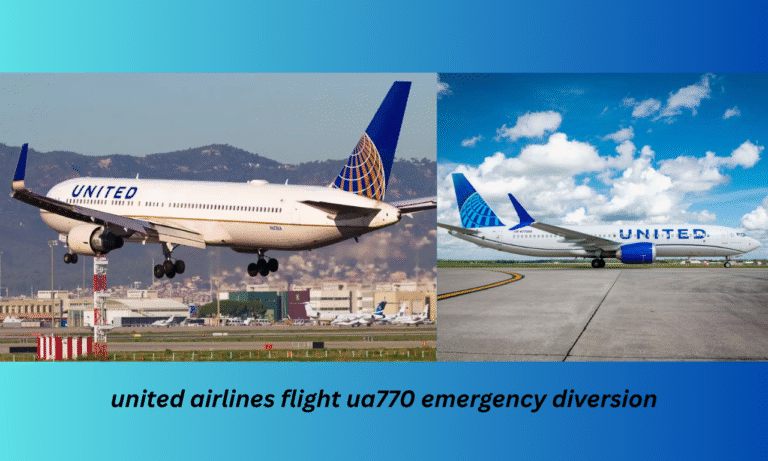I’ll be honest with you—when I first heard the captain announce that our flight was going to make an emergency diversion, my stomach dropped. Flying has always been something I’ve enjoyed, but in that moment, sitting on United Airlines Flight UA770, I was suddenly reminded of just how unpredictable air travel can be.
If you’ve ever experienced something like this, you’ll know the feeling. The sudden silence in the cabin, the looks between strangers, and the million questions running through your head. “What’s wrong? Are we safe? Where are we landing?”
That day, UA770 taught me more about flying, patience, and trust than I’d ever expected. And that’s exactly why I wanted to write about it—not just to share what happened, but to give you an idea of what an emergency diversion really feels like from the passenger’s perspective.
What Happened on United Airlines Flight UA770
United Airlines Flight UA770 started like any other trip. We boarded on time, the flight attendants were their usual friendly selves, and people were settling in with books, movies, or naps. About an hour into the flight, though, things took a turn.
The captain came over the PA system with that calm but serious voice pilots seem to have mastered. He explained that due to a mechanical issue (he didn’t go into much detail, which I now understand is normal), we were going to divert to another airport as a precaution.
At first, there was this hush in the cabin. You could see people exchanging nervous glances. But then something amazing happened: the crew immediately switched gears, moving with this quiet confidence that actually put me at ease.
How the Crew Handled the Emergency Diversion
I’ve always had respect for flight attendants, but after UA770, that respect turned into admiration. They kept their cool the entire time. While a few passengers started panicking, the crew reassured everyone that this was just a precaution and that safety was the top priority.
One thing I noticed was how they over-communicated—which I think was key. Even if they didn’t have all the answers, they kept checking in, telling us what to expect, and encouraging us to stay calm. That steady stream of information made a huge difference.
If you’ve ever wondered how airlines prepare for emergencies like this, I can say firsthand: the training is real, and it shows.
The Landing: A Smooth but Tense Moment
When we finally touched down at the diversion airport, the entire cabin clapped. I know some people make fun of passengers for clapping after landings, but trust me, in that moment, the gratitude was real.
There were emergency vehicles waiting on the runway, which honestly made my heart race. But the landing itself? Smooth as butter. The pilot clearly knew exactly what he was doing, and the relief that washed over the cabin was almost tangible.
What I Took Away from the UA770 Diversion
Looking back, here are a few things I learned that might help if you ever find yourself in a similar situation:
1. Trust the Crew and Pilots
They’re not just trained for this—they’ve drilled for it over and over again. As scary as it felt in the cabin, the crew was in complete control.
2. Stay Calm and Don’t Feed Panic
Easier said than done, right? But I noticed that once a few people started calming down, others followed. Fear spreads quickly, but so does reassurance.
3. Bring Extra Patience When You Fly
Diversions mean delays, waiting around, and sometimes being rebooked on another flight. If you go into flying with flexibility, it makes these curveballs easier to handle.
Why Emergency Diversions Happen More Often Than You Think
What happened on United Airlines Flight UA770 wasn’t unique. Diversions happen for a lot of reasons:
-
Mechanical issues (like ours)
-
Medical emergencies when a passenger needs immediate attention
-
Severe weather that makes it unsafe to continue
-
Security concerns if there’s something suspicious onboard
The important thing to remember is that diversions are done to keep everyone safe, not to scare you.
My Personal Tips for Flying After UA770
After going through this, I’ve changed how I travel a little. Here are two personal tips:
-
Always keep essentials in your carry-on. On UA770, I was glad I had snacks, a water bottle, and my charger. Sitting at the diversion airport waiting for updates would have been so much worse without them.
-
Practice “mental flexibility.” Instead of stressing over delays, I now treat them as part of the travel adventure. It’s not always easy, but it’s saved me a lot of anxiety.
How United Airlines Handled It Afterwards
To their credit, United Airlines was incredibly professional. Once we were safely on the ground, they gave us updates, arranged rebookings for those who needed them, and even offered meal vouchers for the inconvenience.
Sure, no one likes having their plans disrupted. But the way they prioritized safety first and comfort second really impressed me.
Would I Fly United Again After UA770?
Absolutely. If anything, the experience made me trust them more. Knowing that they put safety above all else gave me confidence. Emergencies happen, but it’s how an airline responds that makes all the difference.
Final Thoughts on United Airlines Flight UA770 Emergency Diversion
Sitting on that plane, listening to the engines roar as we diverted, I realized how much we passengers put our trust in the hands of strangers. And you know what? That trust is well-placed.
The United Airlines Flight UA770 emergency diversion was stressful in the moment, but it left me with a strange sense of gratitude. Grateful for the crew, for the pilot’s skill, and for the reminder that safety is never taken for granted in aviation.

